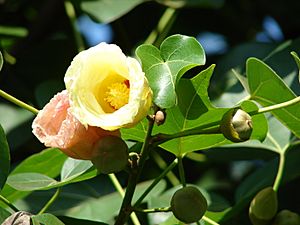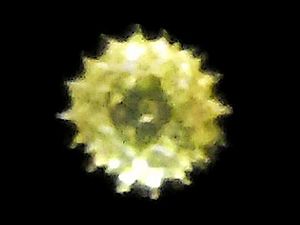Portia tree facts for kids
Quick facts for kids Portia tree |
|
|---|---|
 |
|
 |
|
| Scientific classification | |
| Genus: |
Thespesia
|
| Species: |
populnea
|
| Synonyms | |
|
|
The Thespesia populnea, often called the portia tree, Pacific rosewood, Indian tulip tree, or milo, is a type of flowering plant. It belongs to the mallow family, called Malvaceae. This tree is commonly found in villages in Tamil Nadu, India, and along coasts around the world. However, the Portia tree likely comes from the Old World tropics (areas near the equator in Africa, Asia, and Australia). Long ago, people from Austronesia (islands in Southeast Asia) brought it to the Pacific Islands when they traveled by boat.
Contents
History of the Portia Tree
The Portia tree is originally from the Old World tropics. It is very good at spreading its seeds by sea and growing in island environments. Like a similar tree called Talipariti tiliaceum, the Portia tree was a key source of strong plant fibers. These fibers were used to make ropes and wood for Austronesian outrigger ships and carvings.
Even though its seeds can float and survive in the ocean for months, we haven't found any signs of the Portia tree in Polynesia before the Austronesian expansion. This expansion was a time around 5,000 years ago when people from Austronesia spread across the Pacific. Because of this, the Portia tree is thought of as a "canoe plant." This means that Austronesian travelers purposely carried and planted it on the islands they settled.
In Polynesian culture, these trees were considered sacred, or very special. They were often planted in marae sites, which were important open spaces used for religious and social gatherings. Other trees planted there included Ficus, Fagraea berteroana, Casuarina equisetifolia, and Calophyllum inophyllum.
What the Portia Tree Looks Like
The Portia tree usually grows to be about 6 to 10 meters (20 to 33 feet) tall. Its trunk can be around 20 to 30 centimeters (8 to 12 inches) wide. It can grow from sea level up to about 275 meters (900 feet) high. This tree thrives in places that get between 500 and 1600 millimeters (20 to 63 inches) of rain each year.
The Portia tree can grow in many different types of soil found along coasts. This includes sandy soils (from quartz), soils from limestone, and soils from basalt (a type of volcanic rock). It prefers neutral soils, which means the pH level is between 6 and 7.4. The tiny pollen grains of the Portia tree are about 70 microns wide.
Uses of the Portia Tree
The inner wood, called heartwood, of the Portia tree is a dark reddish-brown to chocolate-brown color. It is quite dense, with a specific gravity (how dense it is compared to water) ranging from 0.55 to 0.89.
Woodworking and Cultural Uses
In Polynesian languages, the Portia tree is known as milo or miro. It is very popular in Hawaii for woodworking, especially for making bowls on a lathe. People love it because its wood has many different colors, from tan to yellow to red. In eastern Polynesia, the tree was traditionally planted in sacred groves. Its wood was used to create religious sculptures.
In Tahiti, Milo wood is used to make the to'ere, which is a type of slotted wooden drum. This drum is used in traditional Tahitian tribal drumming. On Easter Island, Makoʻi wood was used for the famous rongorongo tablets, which have ancient writings.
Since the 1900s, when boats started being made with aluminium, people from the Pitcairn Islands have regularly traveled to Henderson Island. They go there to collect miro wood. Usually, they visit Henderson Island once a year, but they might go up to three times if the weather is good. The Pitcairners carve the wood into small decorative items, called curios. Selling these curios provides a lot of their income.
Other Uses Around the World
In New Ireland, the wood from the Portia tree is used to make hourglass drums. In Tonga, the tree's bark is used as a traditional medicine to treat mouth infections in babies. Its wood is also used to build canoes, parts of houses, and artwork.
In South Asia, the Portia tree's wood is used to make the thavil. This is a musical instrument used in Carnatic music, a type of classical music from South India. The flower of the Portia tree played a special role in Sri Lanka's independence struggle. On Remembrance Day, the Suriya-Mal Movement sold these flowers instead of poppies to help local ex-service members. In ancient Tamilakam, early Tamil people used the wood from this tree to make musical instruments.
See also
 In Spanish: Thespesia populnea para niños
In Spanish: Thespesia populnea para niños


